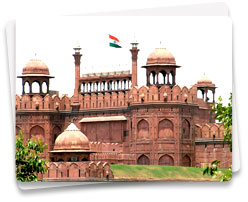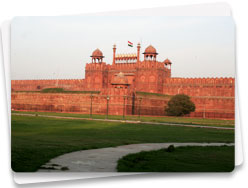Shahjahanabad
Delhi went into something of an eclipse from the time of Humayun's Delhi to the accession of Shahjahan, the great Mughal builder who in 1648 built Shahjahanabad, the seventh city of Delhi. Shahjahan's Delhi, is today more visible than all the Delhi's built before it. The scale on which he built was also more heroic, as can be seen from the Red Fort and the Jama Masjid. The magnificence of the palace (Red Fort - World Heritage Monument at present) is best described in the famous couplet inscribed in the Diwan-i-Khas:
Agar fardos ba rue Zamin ast
Hamin ast a hamin ast a hamin ast.
If paradise be on the face of the earth, it is this, even this, it is this
The celebrated poet Mirza Galib, maintained the same fervour and wrote: "If the world is body, Delhi is the soul". There can be no better attributes for a city.

Shahjahanabad was a walled city, and some of its gates and parts of the wall still stand. The romance of the bazaars of Delhi can be experienced at its best in and around Chandni Chowk and its by lanes. Shahjahanabad was secured and enclosed by about ten kilometer long well. Ten gates connected the city with the surrounding region. Lahore gate was the main entrance for the Red Port besides Delhi Gate. The Kashmere Gate, Calcutta Gate, Mori Gate, Kabul Gate, Faresh Khana Gate, Ajmere Gate and the Turkman Gate were the other major links of the city with the highways. A system of Mohallas and Katras was developed to suit the homogenous community structure. Shahjahanabad who furnishes a fine example of secularism which distinguishes it from the bazars of many historic buildings and temples: The Lal Jain Mandir from the time of Shahjahan, Appa Gangadhar Mandir (Gauri Shankar mandir), the only temple built during Marathi dominion, Arya Samaj mandir (Dewan Hall), Baptist Chruch, Gurudwara Sisganj, Sunehri Masjid and west end terminus, the Fateh Puri Masjid. On 9th March, 1739 Nadir Shah defeated Mohammad Shah at Panipat and entered Delhi. He massacred the inhabitants and took over almost the entire wealth Shahjahanbad, accumulated by the Mughals in India. The Peacock throne, priceless stones such as Koh-i-Nur and Darya-i-Nur, fine pieces of art, thousand of horses, camels, and elephants, and numerous books and manuscripts was carried among as booty.
Till the time the British moved the capital of their Indian Empire from Calcutta to Delhi, the city continued to be battered by invading armies, of the Marathas from the South and Nadirshah, the Persian Emperor, and Ahmad Shah Abdali, the Afghan from the north. All this, of course, was in addition to the bitter rivalries and intrigue which destroyed Delhi from within.
However, immediately after attaining the freedom, Shahjahanabad revived its old pomp and splendour when the first President of free and Democratic India, Dr.Rajendra Prasad drove in State procession in Chandini Chowk on 5.2.1950.










